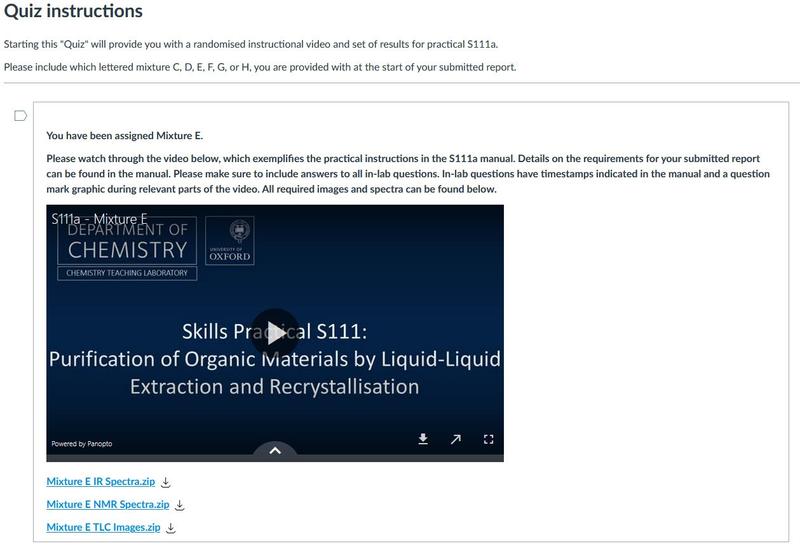- Group size: 210 per year
- Teaching type: Lab-based skills for first-year undergraduates
- Division: MPLS
- Subject: Chemistry
- Tools: Canvas, Panopto
This example may be seen as an application of the FIT pathway: Lab work, which recommends using a blend of learning materials and experiences, both before and after live sessions.
Delivery
Practical lab sessions for first-year Chemistry students have been making use of a mix of in-person lab sessions, supported by remote learning materials. This is an example of blended learning – a blend of in-person sessions (for those who can attend), supported by all the information and resources to enable remote students to complete and submit the required lab report. The Chemistry Teaching Laboratory (CTL) staff recorded video demonstrations of the hands-on experiments conducted in the lab and made these available in Canvas. On starting the Quiz, a student’s path through the practical is defined by the assignment of a random letter by Canvas. This invokes an appropriate video for that student. All the supporting documentation (including a procedure manual) is provided in Canvas. The manual contains the ‘in-lab’ questions, indicated by timestamps to the relevant parts of the video. There are also ‘post-lab’ questions to be answered. Students answer the required questions and submit their report using the Assignments tool.
Strengths
The advantage to this approach is that students who are unable to attend live lab sessions do not completely miss out on all the learning objectives associated with a lab-based task. Students who do attend the in-person lab sessions can watch the video material before attending and this improves the confidence of this particular cohort who have been denied any lab experience since before the end of their pre-university course.
Providing individualised routes through a lab task ensures that student collusion is kept to a minimum. It also increases a sense of student ownership of their task, increasing motivation and engagement.
Limitations
It remains difficult for students working remotely to practise and develop their psychomotor skills, which is a key objective of any modern practical lab course.
Tutors and demonstrators need to find other ways to develop social skills that can be gained through peer-to-peer learning (eg group projects in Canvas), as well as productive, positive working relationships with peers and staff. The FIT pathway: Lab work suggests various combinations of synchronous and asynchronous activities, as well as in-person and virtual meetings.

Figure 1. A screenshot from Canvas illustrating the random assignment of a demonstration, with supporting materials for download
- Contributed by: Drs Malcolm Stewart, Andrew Worrall, Samuel Cahill, Zoe Smallwood, Craig Campbell, Chemistry Department